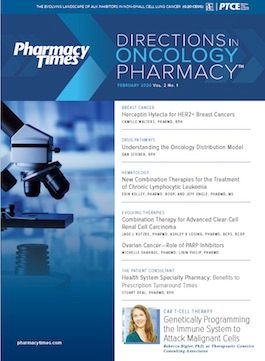Publication
Article
Pharmacy Practice in Focus: Oncology
The Evolution of Oncology Biosimilars and the Potential to Improve Patient Access to Biologics
A session on the use of biosimilars, a topic that many pharmacists identify to be of growing importance in their practices, concluded the 2019 Directions in Oncology Pharmacy conference.
A session on the use of biosimilars, a topic that many pharmacists identify to be of growing importance in their practices, concluded the 2019 Directions in Oncology Pharmacy conference. Leigh M. Boehmer, PharmD, BCOP, who is the medical director for the Association of Community Cancer Centers in Rockville, Maryland, presented this session.
Dr. Boehmer began his presentation by discussing the Drug Price Competition and Patent Term Restoration Act, which most people called the Hatch-Waxman Act. This act describes the abbreviated new drug application pathway and defines generic drugs. Generics can be substituted for brand-name drugs, except when a prescriber designates “Dispense as Written.”
Once biologics entered the pharmaceutical landscape, regulation became more complicated. Biologics are produced using biotechnology in a living system and include growth hormones, monoclonal antibodies, blood products, and cellular therapies. Because these are very large complex molecules, chemists have difficulty characterizing them and subsequently may or may not be able to replicate them as true generics. This is an important issue to understand because currently, roughly 38% of US prescription drug spending is on biologics. Many patients cannot afford these costly medications, and subsequently, a number of pharmaceutical firms have attempted to make generics, or more accurately, biosimilars. Some experts indicate that biosimilars could save the United States as much as $54 billion between 2017 and 2026.
Because this is a complicated topic, the Biologics Price Competition and Innovation Act (BPCIA) was approved to amend the Public Health Service Act. It describes an abbreviated biologics license application for biologics demonstrated to be biosimilars or interchangeable with an FDA-approved product. Biosimilars must be highly similar to the reference product, also called the innovator biologic. Some extrapolation is allowed, and the biosimilars must produce the same clinical results as the reference product in any given patient.
Dr. Boehmer went on to discuss the pharmacology data that are needed to support a demonstration of biosimilarity. This is a stepwise approach to compare the proposed biosimilars with the reference product. The originator biologic is approved after a small amount of analysis, some animal studies, a significant amount of clinical pharmacology work, and a large number of clinical studies. Biosimilars are approved after a large amount of analytical study, a significant amount of animal study, some clinical pharmacology, and a few clinical studies.
Next, Dr. Boehmer discussed a nonproprietary naming for biologics. The FDA updated its draft guidance in March 2019. They intend to designate a proper name combining the core name with the distinguishing suffix devoid of meaning and composed of 4 lowercase letters. The purpose of this guidance was to facilitate the accurate identification of each biologic and minimize inadvertent substitution.
As of early 2018, more than 60 biosimilars were enrolled in the FDA’s biosimilar development program. Dr. Boehmer indicated that currently, clinicians are discussing biobetters. These biologics are recombinant protein drugs in the same class as an existing biologic but designed to be better than the original drug in terms of safety, potency, or efficacy. The FDA-approved biologics in the Purple Book, which describes biosimilar and interchangeable biologics, were discussed. He also briefly discussed certain state-level regulatory requirements.
An interesting section of his presentation covered 5 major knowledge gaps among providers as demonstrated from a survey of more than 1200 providers. Many providers (1) have difficulty defining biologics, biosimilars, and biosimilarity, (2) do not understand the approval process used to evaluate biosimilars, (3) cannot recognize that biosimilars’ safety and immunogenicity are comparable to reference products, (4) do not understand the rationale for indication extrapolation, and (5) cannot explain interchangeability and substitution. This indicates that clinicians’ educational needs are quite extensive.
He stressed that pharmacists need to understand and educate others that the estimated cost to bring a biosimilar to market is about $100 million and can take 5 years or more. Currently, the FDA has approved 14 biosimilars with oncology indications, but they are not all commercially available.
One message that pharmacists can convey is that lower cost associated with biosimilars does not mean they are less effective or less safe. In Europe, studies have demonstrated significant savings. Dr. Boehmer also indicated that pharmacists need to consider the cascade effect; when a biosimilar enters the market, the originator’s price may fall. Biosimilars can increase patient access to biologics. He reviewed a number of studies that support equivalent safety and efficacy when biosimilars are compared to the innovator product.
The pharmacist’s key role is in educating providers and patients so they understand what biosimilars are, and what biosimilars are not. Pharmacists can also advocate for expanded use of biosimilars and help lead discussions in formulary management. Most important, pharmacists have a tremendous responsibility in terms of pharmacovigilance, supporting patient adherence, and reporting of post-marketing adverse events to improve overall patient outcomes.







